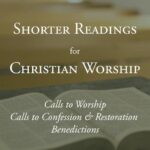Here are English translations and tunes for the oldest early Christian hymns. This is meant to be a worship resource if you are attempting to incorporate the oldest Christian hymns in your gathered worship.
If you’re interested in learning what Early Christian music might have sounded like, then check out my article on the Oxyrhynchus hymn. Both the music and the text are preserved.
The list below does not provide all of the early Christian hymns that are known to modern scholarship; rather, following hymn texts and tunes are the ones that have been used across various denominations and that appear in hymnals.
________________
Shepherd of Tender Youth (Στόμιον πώλων ἀδαῶν, Bridle of Untamed Colts)
Greek hymn title is “Στόμιον πώλων ἀδαῶν (Bridle of untamed colts)” by Clement of Alexandria (c. 150–215); translated into English by Henry Martyn Dexter (1821–1890). See this article at the Hymnology Archive for more on this hymn’s background.
6.6.4.6.6.6.4
YouTube | Hymn Sheet – ITALIAN HYMN (“Come Thou, Almighty King”
YouTube | Hymn Sheet – OLIVET (“My Faith Looks Up to Thee”)
YouTube | Hymn Sheet – KIRBY BEDON
O Gladsome Light (Φῶς ἱλαρόν, Phos Hilaron)
Greek hymn title is “Φῶς ἱλαρόν (Phos Hilaron)” (c. 200); translated into English by Robert S. Bridges (1844 – 1930). See this article at the Hymnology Archive for more on the background of this hymn.
6.6.7.6.6.7
YouTube | Hymn Sheet – NUNC DIMITTIS
YouTube | Hymn Sheet – ASCALON (“Fairest Lord Jesus”)
Father, We Thank Thee Who Hast Planted
This is not an early hymn; rather, it was adapted from the prayers of one of the earliest Christian texts (Greek), the Didache (c. 2nd century); translated into English by Bland Tucker (1895–1984). See The Canterbury Dictionary of Hymnology for more on this hymn.
9.8.9.8 D
YouTube | Hymn Sheet – RENDEZ À DIEU
YouTube | Hymn Text – GENEVAN 98/118
The Apostle’s Creed
The Apostle’s Creed is not a hymn; rather, it is one of the earliest ecumenical confessions of faith. It was probably not composed by the twelve apostles. The exact date of its origin is unclear, but some suggest as early as the fourth century. It was likely based on the “Old Roman Creed” which is believed to have been used as early as the second century. For more on the history of the Apostle’s Creed, see this article by Logos.
YouTube | Hymn Sheet – Emu Music, 2022
YouTube | Hymn Sheet – Townend and Getty, 2016
Hymn Sheet – OESTREICH
Hymn Sheet – MEAD HOUSE
Glory Be to the Father (Gloria Patria)
From earlier Greek worship, known as the “Lesser Doxology” (c. 2nd century, 4th century).
Irregular meter
YouTube | Hymn Sheet – GREATOREX
O Splendor of God’s Glory Bright (Splendor Paternae Gloriae)
From the Latin hymn, “Splendor Paternae Gloriae” credited to Ambrose of Millan (c. 339 – 397); composite translation for English compiled by Louis F. Benson (1855-1930). There is also a composite translation by Robert Seymour Bridges (1844-1930). You can compare translations: Benson, Bridges). See The Canterbury Dictionary of Hymnology for more on this hymn.
8.8.8.8
YouTube | Hymn Sheet – PUER NOBIS
YouTube | Hymn Sheet – WINCHESTER
YouTube | Hymn Sheet – WAREHAM
Come, Thou Redeemer of the Earth (Veni, Redemptor Gentium)
From the Latin hymn, “Veni, Redemptor Gentium” by Ambrose of Millan (c. 339 – 397); translated into English by John Mason Neale (1818–1866). See The Canterbury Dictionary of Hymnology for more on this hymn.
8.8.8.8
YouTube | YouTube | Hymn Sheet – PUER NOBIS
Savior of the Nations, Come (Veni, Redemptor Gentium)
From the Latin hymn, “Veni, Redemptor Gentium” by Ambrose of Millan (c. 339 – 397); translated into German by Martin Luther (1483-1546), then as a composite translation into English from German by mainly William M. Reynolds (1812-1876) and other translators. For more on this hymn, see this article.
7.7.7.7
YouTube | Hymn Sheet – NUN KOMM, DER HEIDEN HEILAND
Holy God, We Praise Your Name (Te Deum)
From the Latin hymn, “Te Deum Laudamus” (c. 4th century); translated into English by Clarence A. Walworth (1820–1900). The meter of Walworth’s translation was modeled after the German version, “Grosser Gott wir loben dich.” For more on the background of this hymn, see this article at Hymnology Archive.
7.8.7.8.7.7
YouTube | Hymn Sheet – GROSSER GOTT
Thee We Adore, Eternal Lord! (Te Deum)
From the Latin hymn, “Te Deum Laudamus” (c. 4th century); translated into English by Thomas Cotterill (1779–1823).
8.8.8.8 (LM)
YouTube | Hymn Sheet – MENDON
YouTube | Hymn Sheet – PARK STREET
YouTube | Hymn Text – HAMBURG (“When I Survey the Wondrous Cross”)
Let All Mortal Flesh Keep Silent (Σιγησάτω πᾶσα σάρξ βροτεία)
A Greek hymn, “Σιγησάτω πᾶσα σάρξ βροτεία,” from the Liturgy of St. James (c. 4th century); paraphrased for English by Gerard Moultrie (1829–1885). For more on the background of this hymn, see this article at Hymnology Archive.
8.7.8.7.8.7
YouTube | Hymn Sheet – PICARDY
YouTube | Hymn Text – REGENT SQUARE (“Angels from the Realms of Glory”)
YouTube | Hymn Text – CWM RHONDDA (“Guide Me, O Thou Great Jehovah)
Of the Father’s Love Begotten (Corde natus ex parentis)
Based on the Latin poem, “Corde natus ex parentis,” by Marcus Aurelius C. Prudentius, an early Christian poet (c. 4th century); translated into English by John Mason Neale (1818–1866). For more on the background of this hymn, see this article at Hymnology Archive.
8.7.8.7.8.7.7
YouTube | Hymn Sheet – DIVINUM MYSTERIUM
YouTube | Hymn Text – CWM RHONDDA (“Guide Me, O Thou Great Jehovah)
O Light That Knew No Dawn (Σὲ τὸν ἄφθιτον μονάρχην)
This is a translation of Gregory of Nazianzus’s (c. 329–389), Archbishop of Constantinople and one of the three Cappadocian Fathers, Greek hymn “Σὲ τὸν ἄφθιτον μονάρχην;” translated into English by John Brownlie (1857-1925).
6.6.6.6.8.8
YouTube | Hymn Sheet – WAVERTON
YouTube – Chris Knaebel, 2013
O Thou, the One Supreme (Σὲ τὸν ἄφθιτον μονάρχην)
A less common translation of Gregory of Nazianzus’s (c. 329–389) Greek hymn “Σὲ τὸν ἄφθιτον μονάρχην” is translated into English by Allen William Chatfield (1808–1896).
6.6.6.6.8.8
Lord Jesus, Think on Me (Μνώεο, Χριστέ)
This was not originally a hymn, but it is based on a Greek prayer from Synesius of Cyrene (c.373–c. 414) which begins with “Μνώεο, Χριστέ, υἱὲ θεοῖο ὑψιμέδοντος, οἰκέτεω σέο;” translated into English by Allen William Chatfield (1808–1896).
6.6.8.6.
YouTube | Hymn Sheet – ST. PAUL
YouTube | Hymn Sheet – ST. BRIDE
YouTube | YouTube (vocal) | Hymn Sheet – SOUTHWELL
YouTube | Hymn Sheet – Greg Wilbur’s adaptation of SOUTHWELL
We All Believe in One True God (Πιστεύομεν εἰς ἕνα Θεὸν from The Nicene Creed)
The Nicene Creed is not originally a hymn; it is a Greek creed composed at the Council of Nice in 325 and later amended in 381 at the First Council of Constantinople. It has been translated and versified many times through the years. A popular German setting of “Wir Glauben All’ en einen Gott” by Martin Luther (1483-1546) exists as a composite translation in English as “We all believe in one true God ” (8.8.8.8 D) with major contributions from Richard Massie (1800-1887) and Herman Brueckner (1866–1942). Tobias Clausnitzer’s (1619−1684) German setting was translated as “We believe in one true God” (7.7.7.7.7.7) by Catherine Winkworth (1827–1878).
8.8.8.8 D and 7.7.7.7.7.7
YouTube | Hymn Sheet – WIR GLAUBEN ALL (Wagner)
YouTube | Hymn Sheet – RATISBON
Sing, My Tongue, the Glorious Battle (Pange Lingua Gloriosi Lauream Certaminus)
Latin hymn, “Pange lingua gloriosi lauream certaminus,” by Venantius Fortunatus, Christian poet and hymn writer (c. 6th century); translated into English by John Mason Neale (1818–1866). See The Canterbury Dictionary of Hymnology for more on this hymn.
8.7.8.7.8.7
YouTube | Hymn Sheet – RHUDDLAN
YouTube | Hymn Text – HYFRYDOL (“Jesus What a Friend for Sinners,” add the first two lines of each stanza to the end of each stanza)
YouTube | Hymn Text – HYMN TO JOY (“Joyful, Joyful, We Adore Thee,” add the first two lines of each stanza to the end of each stanza)
Thirty Years Among Us Dwelling (Pange Lingua Gloriosi Lauream Certaminus)
Another setting from the hymn, “Pange lingua gloriosi lauream certaminus” by Venantius Fortunatus, is a second and less known translation by John Mason Neale (1818–1866). See The Canterbury Dictionary of Hymnology for more on this hymn.
8.7.8.7.8.7
See the Destined Day Arise
Paraphrased from two verses of a Latin hymn, “Pange Lingua Gloriosi Prœlium Certaminis,” by Venantius Fortunatus, Christian poet and hymn writer (c. 6th century); translated into English by Richard Mant (1776-1848).
7.7.7.7
YouTube | Hymn Sheet – HALLE
YouTube | Hymn Sheet – ST. DUNSTAIN (Redhead 47)
YouTube | Hymn Sheet – DULCOT
YouTube | Hymn Text – VENIT HORA
YouTube | Hymn Sheet and Lead Sheet – Matt Merker’s tune plus chorus
Come, Ye Faithful, Raise the Strain (Αϊσωμεν, πάντεζ λαοί)
Greek hymn by John of Damascus (c.675–c.754), poet and church father; translated into English by John Mason Neale (1818–1866). See this article at the Hymnology Archive for more on this hymn’s background.
7.6.7.6 D
YouTube | Hymn Sheet – GAUDEAMUS PARITER
YouTube | Hymn Sheet – ST KEVIN
The Day of Resurrection (Άναστάσεως ήμέρα)
Greek hymn by John of Damascus (c.675–c.754), poet and church father; translated into English by John Mason Neale (1818–1866). See this article at the Hymnology Archive for more on this hymn’s background.
7.6.7.6 D
YouTube | Hymn Sheet – LANCASHIRE (“Lead on O King Eternal”)
YouTube | Hymn Sheet – ELLACOMBE (“I Sing the Mighty Power of God”)
YouTube | Hymn Sheet – ROTTERDAM
Christ Is Made the Sure Foundation (Angularis fundamentum)
Latin hymn title was “Angularis Fundamentum” (c. 6th or 7th century); translated into English by John Mason Neale (1818–1866). See The Canterbury Dictionary of Hymnology for more on this hymn.
8.7.8.7.8.7
YouTube | Hymn Sheet – WESTMINSTER ABBEY
YouTube | Hymn Sheet – REGENT SQUARE (“Angels from the Realms of Glory”)
YouTube | Hymn Sheet – UNSER HERRSCHER
Be Thou My Vision (Rop tú mo Baile)
From an 8th-century Irish poem called “Rop tú mo Baile”; adapted as an English hymn by Eleanor Hull (1860–1935). See this article from Hymnology Archive for more on the background of this hymn.
10.10.10.10
YouTube | Hymn Sheet – SLANE
All Glory, Laud, and Honor (Gloria, Laus et Honor)
From “Gloria, laus et honor” by Theodulph of Orleans (c.750–821), bishop in France during the reign of Charlemagne; translated into English by John Mason Neale (1818–1866). See this article from Hymnology Archive for more on the background of this hymn.
7.6.7.6 D
YouTube | Hymn Sheet – ST. THEODULPH
Father, Most Holy (O Pater Sancte)
Latin hymn title was “O Pater Sancte” (c. 900); English translation by Percy Dearmer (1867–1936). See The Canterbury Dictionary of Hymnology for more on this hymn.
11.11.11.5
YouTube | Hymn Sheet – CHRISTE SANCTORIUM
YouTube | Hymn Sheet – HERZLIEBSTER JESU
________________
For this project, I am indebted to Chris Fenner at Hymnology Archive, Hymnary, Andrew Remillard (who has recorded many of these hymns), and Scott Aniol and Bert Polman (whose hymnals contain many of these hymns).
Bibliography
Brownlie, John. Hymns of the Greek Church. Edinburgh: Oliphant Anderson & Ferrier, 1900. Archive. Project Gutenberg.
Church, F. Forrester and Terrence J. Mulry, eds. The Macmillan Book of Earliest Christian Hymn. New York: Macmillan Publishing Company, 1988. Archive.
Frost, Maurice. Historical Companion to Hymns Ancient and Modern. London: William Clowes & Sons, Limited, 1962.
McGuckin, John A. At the Lighting of the Lamps: Hymns of the Ancient Church. Harrisburg, PA: Morehouse Publishing, 1995. Archive.







